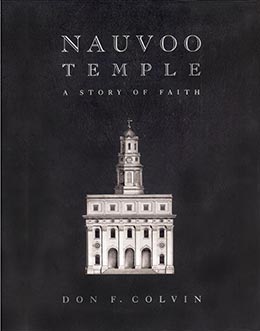Preface
Don F. Colvin, The Nauvoo Temple: A Story of Faith (Provo, UT: Religious Studies Center, Brigham Young University, 2002), viii–ix.
While researching this history I have developed great respect and appreciation for those pioneer builders who sacrificed so much and worked so hard to construct the magnificent Nauvoo Temple. I have been constantly amazed by the skill of their work and the excellence of their efforts. The quality of their labor did not diminish even when they were faced with leaving it all behind. Theirs was a sacrifice of devotion and a gift to God. They gave their very best in spite of difficult circumstances. My deepest gratitude goes to those who left behind firsthand descriptions, experiences, and observations in writing. Their journals, letters, and articles have been invaluable sources of information.
This book reveals the dedicated struggle of pioneers, who, in the face of great obstacles, sacrificed for the fulfillment of their religious ideals and convictions. It reviews the early setting in which the Nauvoo Temple was constructed, the theology that led to its erection, and the struggle of construction from when the building was first contemplated until its dedication. The text brings together in more complete form than previously published the pertinent information relating to the temple's construction, varied uses, and eventual fate. It also brings into focus the faith and dedication of its builders, who steadily pushed the project to completion in spite of intense persecution. Insights are also provided into the sacrifices involved in supplying the manpower, skills, means, and materials essential to the temple's construction, showing that some even gave all their earthly possessions toward the building's erection.
In a more complete form than ever before published, this book brings together the most detailed and pertinent information and descriptions regarding the external and internal physical features of the Nauvoo Temple. Helpful illustrations are also included, enabling readers to visualize the intricate designs, features, and architecture of this majestic building.
The problems and issues surrounding the temple's completion are treated in detail in relation to each section of the building. From the point of view of architectural design, the temple was not totally finished, and had the builders been permitted to remain in the city, they would have further embellished the building, giving a finer finish to several areas of the structure. Clear evidence, however, shows that from a functional point of view the building was completed and contained all of its designed sections, of which each was accessible. Though only roughed in, some portions of the building were still put to effective use while the building stood. This book also concludes that the temple was graced by a golden statue of an angel placed at or near the apex of the tower, lying in a horizontal position, which served as a weather vane. The destruction of the temple by fire, the eventual demolition of the walls, and the disposition of the temple site are all traced to the present time.
To the greatest degree possible, this study has concerned itself with material from original sources such as private journals, newspaper accounts, historic writings, letters, and other written materials originating in the period when the temple was built. I have endeavored to honestly quote and give proper credit to all these valuable sources of information. This text is limited only to those parts of that history that have direct bearing on the story of the temple. It does not attempt to address problems between the Mormons and their neighbors, nor does it deal with other areas of interest that developed over the period of construction.
This book also addresses the nature and early practice of temple ordinances along with the great desire of church members to obtain these sacred blessings. This study furnishes valuable insights into the historical development of these temple ordinances as practiced by The Church of Jesus Christ of Latter-day Saints. Additional ordinances such as baptisms for healing, plural marriages, and other higher temple ordinances were also performed in the Nauvoo Temple, but these are not emphasized in this book for two reasons: first, they were not the primary purposes of temple ordinances, and second, the information dealing with higher ordinances approaches an area of sacredness that I feel would be improper to write upon.
The impact of the Nauvoo Temple on Church doctrine and practice has been significant and long-lasting, and the nature of this influence is traced within the book. The construction of this temple not only proved to be a spiritual blessing to the Mormon people, but it physically unified them in a common goal. The economic impact of this construction project was also important as the temple provided jobs for numerous individuals and fostered numerous support industries and businesses that contributed significantly to the economic growth of the city.
From a personal frame of reference I must pay special tribute to my own great-great-grandparents Richard and Louisa Sprague. Richard Demont Sprague worked as a stonemason, assisting in building the walls of the Nauvoo Temple. He was selected by the city council to serve as a police officer, and he stood guard over the temple and other buildings in the city. On 22 January 1846 they received their endowments in the Nauvoo Temple, and one week later, on 29 January 1846, they were sealed in the temple as husband and wife for time and for all eternity. To these noble pioneers, my great-great-grandparents, I will be forever indebted. Their faith, sacrifice, devotion, integrity, and character are a rich legacy for me and my family.
Though I write from a position of faith, it has been my endeavor to be honest and accurate. I do possess strong convictions and a firm testimony that the hand of God attended the construction of this great temple. It is my observation that God's Spirit guided this work and was clearly manifested in meeting and ordinances conducted within this sacred building. I come away from this experience with my faith deeply enriched.
